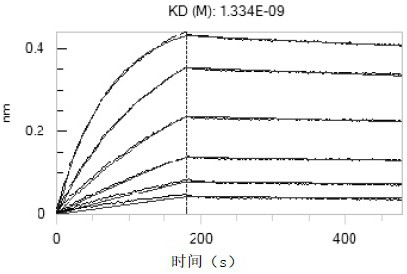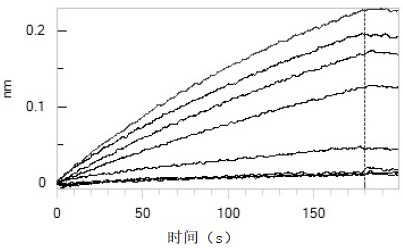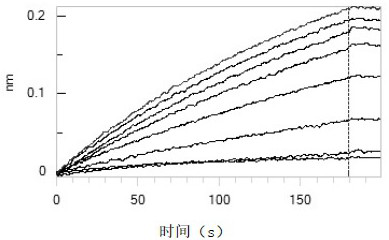Method for detecting novel coronavirus neutralizing antibody by using BLI technology
A coronavirus and technical detection technology, applied in the biological field, can solve the problems of inability to achieve high-throughput detection, many steps, and long time, and achieve the effect of qualitative and quantitative detection and simple operation
- Summary
- Abstract
- Description
- Claims
- Application Information
AI Technical Summary
Problems solved by technology
Method used
Image
Examples
Embodiment 1
[0040] Example 1 Binding experiment of novel coronavirus spike protein RBD and human ACE2
[0041] 1. Protein preparation: Dilute human ACE2 protein to 10 μg / mL, add 200 μL per well into a black 96-well plate, dilute the new crown spike protein RBD from 100 nM to 2-fold concentration gradient, and add 200 μL per well to the analysis sample column .
[0042] 2. Set up the program for detection: first capture the same concentration of human ACE2 on the sensor, and then combine with different concentrations of the new crown spike protein RBD.
[0043] The binding curve of novel coronavirus spike protein RBD and human ACE2 is shown in figure 1 .
Embodiment 2
[0044] Example 2 New crown neutralizing antibody blocking experiment
[0045] This embodiment provides a short time-consuming, high-throughput, and highly sensitive method for screening novel coronavirus neutralizing antibodies using BLI technology. This method can realize the screening of new crown neutralizing antibodies within 15 minutes, and the operation is simple and does not require Wash the plate several times. The method includes:
[0046] 1. Prepare protein and antibody: Dilute human ACE2 protein to 10 μg / mL, add 200 μL per well to the Load column, dilute the new crown spike protein RBD to 50 nM, and dilute the new crown neutralizing antibody 1.5 times from 54 nM , Mix the diluted new crown spike protein RBD and new crown neutralizing antibody in equal volumes, and add 200 μL of the mixed new crown spike protein RBD and new crown neutralizing antibody to the analysis sample column per well.
[0047] 2. Set up the program for detection: first capture the same concen...
Embodiment 3
[0053] Example 3 Optimization of the RBD concentration of the new crown spike protein
[0054] Taking the new crown neutralizing antibody antibody2 as an example, by optimizing the concentration of the new crown spike protein RBD (100nM, 50nM, 25nM, 12.5nM), the IC was determined 50 Value and detection range, and compare the detection sensitivity under different conditions. The results are shown in Table 1:
[0055]
[0056] From the above experimental results, it can be seen that as the concentration of the new crown spike protein RBD decreases, the detection range becomes wider, and the IC 50 The lower the value, the higher the sensitivity, but the concentration of the new crown spike protein RBD should not be too low, otherwise the detection signal will decrease accordingly, so the final concentration of the new crown spike protein RBD of 25nM is the best.
PUM
 Login to View More
Login to View More Abstract
Description
Claims
Application Information
 Login to View More
Login to View More - R&D Engineer
- R&D Manager
- IP Professional
- Industry Leading Data Capabilities
- Powerful AI technology
- Patent DNA Extraction
Browse by: Latest US Patents, China's latest patents, Technical Efficacy Thesaurus, Application Domain, Technology Topic, Popular Technical Reports.
© 2024 PatSnap. All rights reserved.Legal|Privacy policy|Modern Slavery Act Transparency Statement|Sitemap|About US| Contact US: help@patsnap.com










